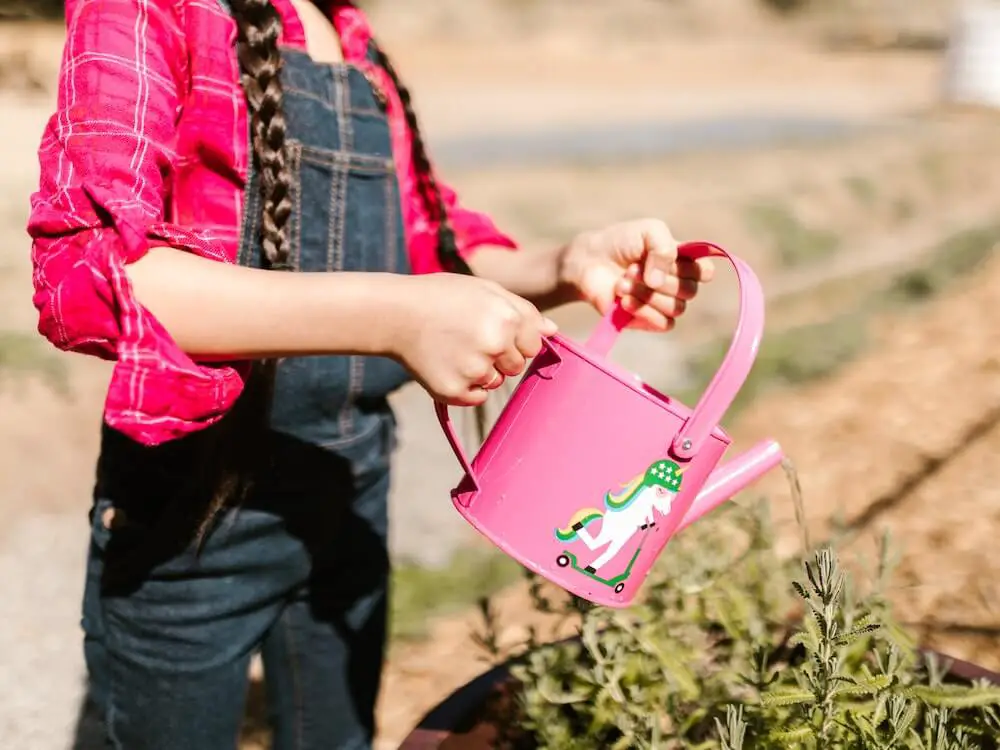How to Make a Small Garden Child-Friendly
October, 2022 |If you have a small garden, you’ll know that space is precious. Whether you have a balcony, rooftop or tiny backyard, creating a multifunctional space that the whole family can enjoy can be a balancing act.
With limited space, it can be difficult to fit all the usual child-friendly, fun garden activities in. Trampolines and swing sets are generally not balcony-friendly! And a jungle gym may fit in your backyard, but it might be the only thing that does.
So how can you make a small garden child-friendly and keep kids safe and entertained in limited garden space?
How to make a small garden child-friendly
From creative outdoor play ideas to poisonous plants to avoid, discover 8 ways to make your mini garden space child-friendly, while still keeping it looking stylish too!
1. Have a clear space to play
If you have the space, make sure you leave a soft surface where children can spread out their toys and games.
You could lay some turf or soft playground bark clippings that children can safely walk over and play on.
A simple cleared space allows their imaginations to run wild instead of being restricted to paved pathways along borders bursting with plants.

2. Add sensory plants
Fragrant plants with sweet or aromatic scents are always a fun addition to any garden. Lemon balm, mint, thyme, and rosemary all have a stimulating scent, plus they can also be used as medicinal herbs too.
Other child-friendly plants to include could be nasturtiums, pot marigolds, and dahlias. Their bright colors and ornamental flowers are really attractive, plus they’re all edible too!

3. Create a mini container pond
If you’d like to add a water feature, Instead of a sunken pond, consider adding a small container pond in an old half barrel or a mini fountain. It’s a much better option for a small garden with little children wandering about. It also takes up less space and can be moved around.
Having water in a garden is a lovely sensory experience for children, and it can be a great way for them to experience water-based wildlife too!
Disclaimer: Remember children must be monitored around any pools or water features.
4. Create a space to grow some food and flowers together!
Showing children how to sow seeds and look after their own plants is a great opportunity for them to learn about food and nature.
Set aside a small area, or a few containers, where they can sow, grow, and harvest their own plants.
If you have a small balcony, a vertical vegetable garden with stepped planters could be a great way to pack more veg into limited space.
Easy to sow vegetables
Growing vegetables is a fun activity and will provide children with some special core memories. Choose easy-to-sow vegetables with large seeds that are easy to handle.
Some easy vegetables for children to grow include:
- Quick growing vegetables like radishes, spinach, and beets have big seeds that children can easily plant themselves.
- Bush beans
- Dwarf peas
Vegetables that are fun to harvest
Planting high yielding vegetables such as dwarf tomatoes or pole beans is another great way to engage children with the vegetable garden. They’re fun to harvest, and children can enjoy picking vegetables every few days!
Dwarf fruit trees are another great option to add fruit trees to your mini garden space. Their small height and fruit accessibility make it easier for children to pick their own fruits.
If you only have windowsill space, check out these crops you can grow indoors on a windowsill.
Easy-to-grow flowers
Watching the transformation of little seeds turning from seedlings into fully grown flowers is always a rewarding experience — no matter how old you are!
Some fun flowers for children to grow:
- Dwarf sunflowers
- Nasturtiums
- Marigolds
- Calendula
You could also create a compost bin which can teach them about the importance of recycling kitchen waste. You can even create a compost bin on a balcony too.

5. Avoid toxic or spiked plants
There are lots of inedible plants in the world, many are harmless, however, there are some very popular garden flowers that are highly toxic to humans and pets.
The following plants are generally best avoided until small children can understand the danger.
Toxic garden plants to avoid:
- Foxgloves
- Lily of the Valley
- Bluebells
- Frangipani
- Monkshood
- Oleander
- Jack-in-the-pulpit
- Delphiniums
- English yew trees
- Euphorbia species (spurge, poinsettia)
Be wary of small trees or shrubs with ornamental but poisonous berries or fruits (holly or yew), their juicy red berries may look appealing to little ones.
Spiky garden plants you may want to avoid:
- Roses
- Barberry
- Holly
Some dwarf conifers are spiked too, so double-check the plant’s characteristics, especially before buying plants online.

6. Create a mini ‘play garden’ container
Fill a planter with soil or compost and start adding tiny plants like dwarf conifers or miniature hostas. Sprinkle bark chips in between the plants and you’ll have created your own mini garden landscape!
Children can use these tiny gardens as mini playgrounds for action heroes, dolls, and farm animals.
You could also create a mini fairy garden too! Add a tree stump, woodland ferns, mini solar lights, and a fairy front door, to create a magical mini garden that children will love playing with.

7. Mini garden tools and toys
Make sure you have a mini watering can so that small children can easily hold the can and water their own plants. It’s a great way to engage them with nature and the responsibility of looking after something.
You could also find some mini buckets, wooden spoons, or spades that children could use to make their own garden ‘recipes’. With a herb garden filled with echinacea, mint, or arugla, children can safely pick and handle plants, plus it will encourage more growth and keep plants healthy too!
To really spark creativity, you could add a paving stone (or even paint a wall with chalkboard paint) and let children draw with chalk!

8. Create a ‘secret garden’ area
Even in a small garden, you can use tall plants, panels, or clever planting techniques to create dens and ‘secret garden’ spaces. Here are some ideas that can help you create interest, even in a mini garden space…
- You could create a mini den area using sticks and encourage an evergreen climbing plant to cover the top.
- Train two small willow trees into an archway by loosely plaiting their long branches together. This could be used as an entrance to the ‘play zone’ area of a garden.
- Add a garden arbor where you can grow climbing plants across, maybe even some mini pumpkin varieties!
- Use screening plants like grasses or bamboo (even some columnar fruit trees) to divide your garden into different zones to add interest and separate the ‘relaxed’ and organized garden space from the play zone.

Creating separate areas can inspire a sense of adventure and wildness, especially in a small garden space where a swing set or slide won’t fit.
Featured Image: Photo by RODNAE Productions





